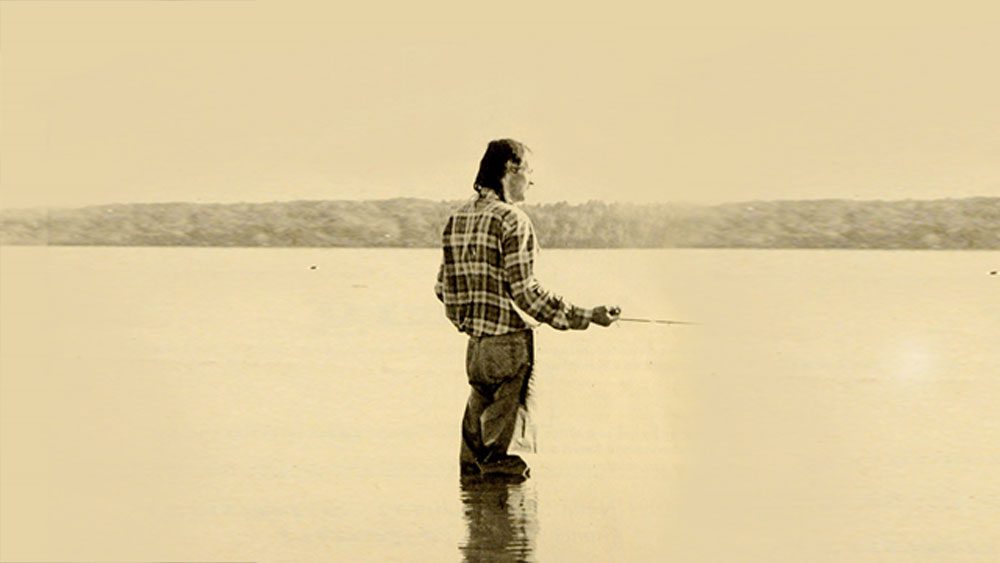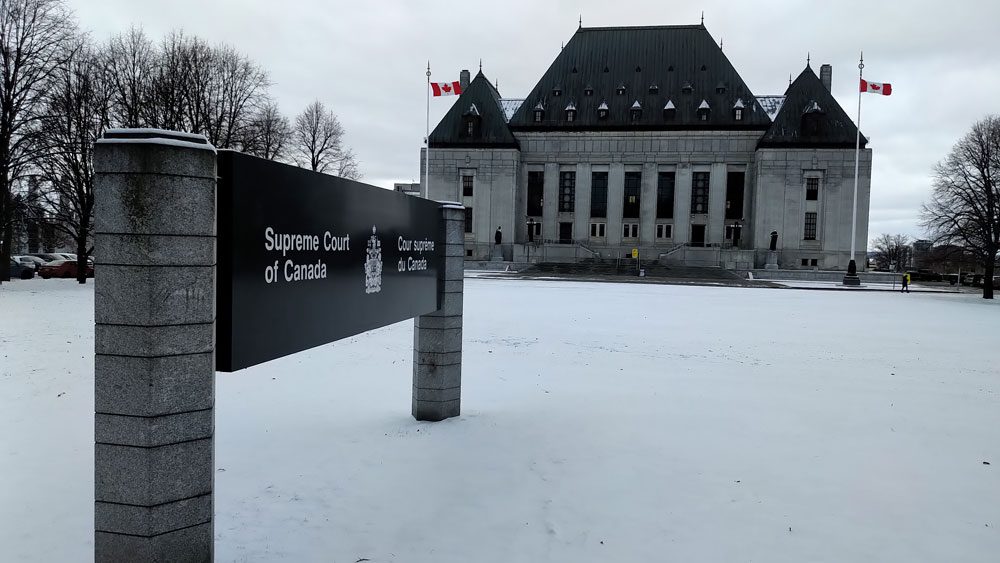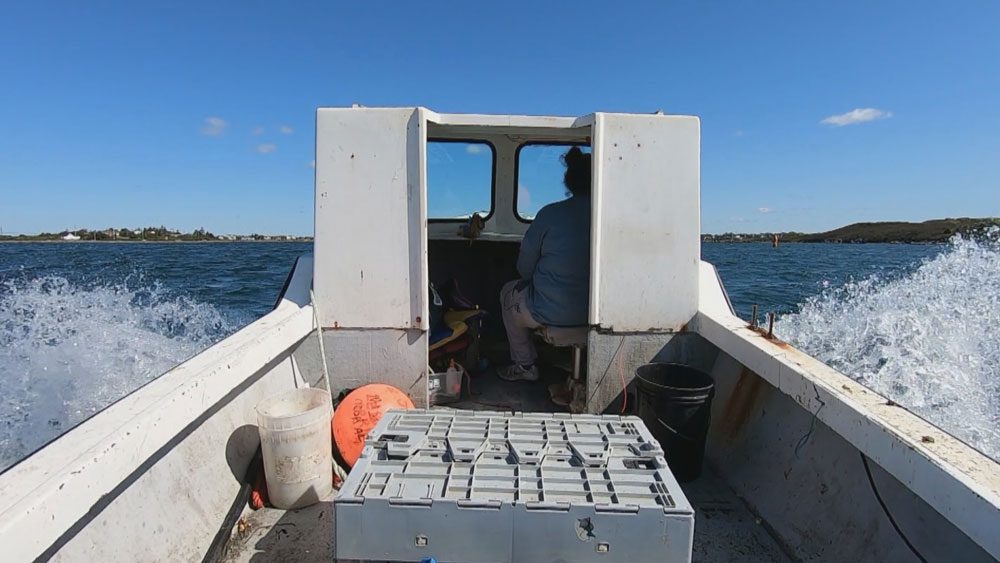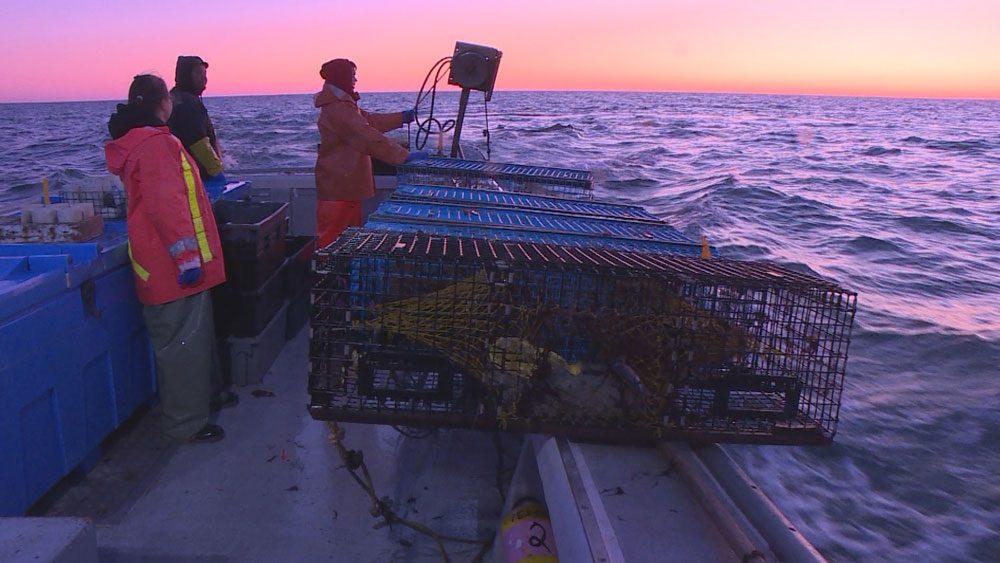Early on a warm morning in mid-August, Marilyn-Leigh Francis eyes the Coast Guard boat at the wharf in Yarmouth, Nova Scotia.
Officers for the Department of Fisheries and Oceans (DFO) are gearing up to head out on the water.
Word around the wharf is that the DFO officers will be hauling up any lobster traps that aren’t tagged for the Mi’kmaw food fishery season that’s underway.
For the last four years, Francis has harvested lobster, outside of the rules set by the DFO.
No licence. No tags.
She writes her name and Treaty 1752 on her buoys.
Francis, who is from the Acadia First Nation, is asserting her inherent right as a Mi’kmaw woman.
She provides food for her family, gives some of the lobster away, and sells and trades the rest.
Francis walks up to one of the DFO officers, introduces herself, and asks, “I was just wondering if you guys were seizing gear today?”
The officer says he doesn’t know.
But for the rest of summer and into the early fall, the DFO was busy seizing traps.
By October, a large, fenced in compound at one of their offices in western Nova Scotia is full.
(Marilyn-Leigh Francis in her boat. Francis is asserting her inherent right as a Mi’kmaw woman to fish and provide for her family. Photo: Trina Roache/APTN)
The Mi’kmaq are the only people harvesting lobster this time of year in southwest Nova Scotia.
It’s part of the food fishery.
The catch can be used for food, social, or ceremonial purposes but can’t be sold.
DFO officers have seized Francis’ gear and threatened to charge her numerous times in previous years.
“They’ve set up hidden sting operations. I’ve sold lobsters to DFO officers,” said Francis. “I could understand if I was going out and I had a 40-foot boat with a hundred traps, right? I have, like, an 18-foot boat with eight traps.”
Francis isn’t alone.
More and more Mi’kmaq are engaging in what they call a rights-based, or livelihood fishery, similar to how Donald Marshall Junior caught and sold eels when the DFO charged him in 1996.
Marshall was already an iconic Mi’kmaw figure. He had been wrongfully convicted of murder and spent eleven years in prison.
A Royal Commission into his wrongful conviction revealed deep racism within Nova Scotia’s justice system.
Membertou Chief Terry Paul was Marshall’s lifelong friend.
“You could tell that he was really scarred by his experience being in prison,” said Paul.
(‘I remembered thinking that we won’t be hungry anymore,’ says Terry Paul of his friend Donald Marshall, above fishing, when the Supreme Court ruled on his case. Photo Courtesy to Stephen Marshall, Micmac News, 1991)
For Marshall, fishing became a way to move forward, and reconnect with his culture.
“I talked to him pretty well every day while he was fishing and when the DFO officers were harassing him,” said Paul. “Here’s a person that went through eleven years of prison and then the system is after him again.”
As Marshall’s case went through the courts, the Mi’kmaq argued that under the Treaty of 1760-61, he had a right to barter and trade any goods he could hunt, fish, and gather so he could make a living.
In 1999, the Supreme Court of Canada upheld Mi’kmaw treaty rights and Marshall was acquitted.
“I mean everybody cried for joy,” said Paul, still emotional at recalling the moment two decades later.
“And I remembered thinking that we won’t be hungry anymore. Everybody hugged each other. And it was just a tremendous feeling of relief. Finally. Finally, somebody listened to us. They listened to Junior.”
The Mi’kmaq celebrated by going fishing, setting out in small boats with a few lobster traps to access a lucrative resource they had been historically denied.
The Mi’kmaq argued that under the Treaty of 1760-61, he had a right to barter and trade any goods he could hunt, fish, and gather so he could make a living.
In 1999, the Supreme Court of Canada upheld Mi’kmaw treaty rights and Marshall was acquitted.
The Mi’kmaq celebrated by going fishing, setting out in small boats with a few lobster traps to access a lucrative resource they had been historically denied.
In places like Esgenoôpetitj, commonly called Burnt Church, confrontation with the DFO, RCMP, and non-Mi’kmaw fishermen followed.
Canada’s response to the Marshall decision was to sign fishing deals with bands in the Atlantic region that included $600 million for gear, boats, training and access to the existing commercial fishery.
In 2019, the commercial fisheries is an economic driver for Mi’kmaw and Wolastoqiyik communities, with revenues of $125 million a year and over 1,800 jobs.
But commercial access was never considered an implementation of the Marshall decision.
“If you have a party, i.e. government who’s got the power, who just won’t do it, what are the mechanisms?” asked Eric Zscheile.
Zscheile was one of Donald Marshall Junior’s lawyers in the historic case 20 years ago.
Today, he’s a lawyer for the Mi’kmaq Rights Initiative, a group that represents the Assembly of Nova Scotia Chiefs at the negotiation table.
“I always get nervous if I’m in discussions with a party where that party has everything to gain by nothing happening, because what’s their motivation to get anything done?” he said.
Today, the only Indigenous fisheries regulated by the DFO are the commercial and food fisheries.
Fishing the same way Marshall did is still illegal.
“What did the Supreme Court say? We have to have a livelihood fishery. There is a Section 35 constitutional right to a livelihood fishery,” said Zscheile.
“How hard is it to create a third category of fisheries?”
If conservation isn’t a concern, and the DFO is only seizing gear or laying charges because a Mi’kmaw person is selling their catch without a commercial licence, “well, that’s an infringement of the treaty right,” Zscheile said.
Kevin Anderson is a senior advisor on Indigenous relations for DFO.
He said the department is mandated to regulate an orderly fishery and that conservation is a top priority.
But added that the DFO is committed to meeting its treaty obligations.
“What we’re really talking about is, how do you manage the fishery? Things like seasons and different seasons for different activities. And the regulatory construct is fairly flexible on that side,” said Anderson.
“Really, what you’re talking about is a small scale fishery. Now the specifics of it, that’s to be negotiated.”
(Kevin Anderson is a senior advisor on Indigenous relations for DFO. Photo: Trina Roache/APTN)
A new round of negotiations began in 2017.
“Fundamentally more, it does recognize the right exists which I think is a major move for Canada. It probably should’ve been done 20 years ago. It wasn’t,” said Jim Jones who was a regional director for the DFO when the Marshall Decision came down.
Today, he’s the federal negotiator for the new Rights Reconciliation Agreements on the table now.
“Part of the discussion is to figure out how what a moderate livelihood fishery could entail, could look like, and then how do we put that in place and develop the management in concert with the communities,” he said.
The Supreme Court agreed and came up with the term “moderate livelihood” to describe the treaty right to make a living but didn’t define it.
“You can’t put a dollar figure on our rights, on our treaties,” said Alex MacDonald, former chief of Sipekne’katik First Nation and a long-time Mi’kmaw fish harvester.
He said the livelihood fishery that some Mi’kmaq do is a drop in the bucket compared to the catch and profits in the non-Mi’kmaw industry.
Within the commercial lobster fishery, Mi’kmaq and Wolastoq First Nations make up just under four per cent of the $1.2 billion in total landed value for 2016.
“You have non-native fishermen that make millions of dollars every year. What is their moderate livelihood? Who do you compare with, you know?” asked MacDonald. “And why does ours have to be belittled? Why does it have to be minimum?
“All these resources that have been taken from my land,” said MacDonald, “we should be the richest people in Canada, not the poorest. But yet we’re the poorest people.”
(Mi’kmaw fish harvesters get ready to dump their traps off the coast of Mi’kma’ki. Photo: Trina Roache/APTN)
The Mi’kmaw leadership is also trying to come up with an idea of what a moderate livelihood looks like.
In Membertou, Paul holds the fisheries portfolio for the Assembly of Nova Scotia Chiefs and he hosted a conference focused on the question.
“We need to get good action going on this so that we’re able to allow our people to go out fishing without being harassed,” said Paul.
“We have to have rules but it doesn’t have to be the Fisheries Act,” he said. “What we would like to come up with is a Mi’kmaq Fisheries Act, that we have our own act.
“It’s a treaty right,” said Paul. “It’s a Supreme Court decision that has to be abided by in this country.”


















Commercial access was intended by The Supreme Court as both decisions in Rv.Marshall required it when the Ruling was to be carried out.